Active Control of Low-Frequency Noise through a Single Top-Hung Window in a Full-Sized Room
Abstract
Featured Application
Abstract
1. Introduction
2. Materials and Methods
2.1. Experimental Setup
2.2. Active Control Formulation
2.3. System Characteristics
2.4. Primary Noise Types
2.5. Evaluation Criteria
3. Results
3.1. Passive and Active Attenuation Performance
3.2. Attenuation Performance as a Function of Frequency
4. Discussion and Conclusions
Author Contributions
Funding
Acknowledgments
Conflicts of Interest
References
- World Health Organization Regional Office for Europe. Environmental Noise Guidelines for the European Region; The Regional Office for Europe of the World Health Organization: Copenhagen, Denmark, 2018; ISBN 9789289053563. [Google Scholar]
- Murphy, E.; King, E.A. Environmental Noise Pollution; Elsevier: Amsterdam, The Netherlands, 2014; ISBN 9780124115958. [Google Scholar]
- De Salis, M.H.F.; Oldham, D.J.; Sharples, S. Noise control strategies for naturally ventilated buildings. Build. Environ. 2002, 37, 471–484. [Google Scholar] [CrossRef]
- Tang, S.-K. A Review on Natural Ventilation-enabling Façade Noise Control Devices for Congested High-Rise Cities. Appl. Sci. 2017, 7, 175. [Google Scholar] [CrossRef]
- Torresin, S.; Albatici, R.; Aletta, F.; Babich, F.; Oberman, T.; Siboni, S.; Kang, J. Indoor soundscape assessment: A principal components model of acoustic perception in residential buildings. Build. Environ. 2020, 182, 107152. [Google Scholar] [CrossRef]
- International Organization for Standardization. ISO 12913-1: Acoustics—Soundscape—Part 1: Definition and Conceptual Framework; International Organization for Standardization: Geneva, Switzerland, 2014. [Google Scholar]
- International Organization for Standardization. ISO/TS 12913-2: Acoustics—Soundscape—Part 2: Data Collection and Reporting Requirements; International Organization for Standardization: Geneva, Switzerland, 2018. [Google Scholar]
- International Organization for Standardization. ISO/TS 12913-3: Acoustics Soundscape, Part. 3: Data Analysis; International Organization for Standardization: Geneva, Switzerland, 2019. [Google Scholar]
- Torresin, S.; Albatici, R.; Aletta, F.; Babich, F.; Oberman, T.; Kang, J. Acoustic Design Criteria in Naturally Ventilated Residential Buildings: New Research Perspectives by Applying the Indoor Soundscape Approach. Appl. Sci. 2019, 9, 5401. [Google Scholar] [CrossRef]
- Ranjan, R.; He, J.; Murao, T.; Lam, B.; Gan, W.-S. Selective Active Noise Control System for Open Windows using Sound Classification. In Proceedings of the INTER-NOISE and NOISE-CON Congress and Conference Proceedings, InterNoise16, Hamburg, Germany, 21–24 August 2016; pp. 482–492. [Google Scholar]
- Shi, D.; Gan, W.-S.; Lam, B.; Wen, S. Feedforward Selective Fixed-filter Active Noise Control: Algorithm and Implementation. IEEE/ACM Trans. Audio Speech Lang. Process. 2020, 28, 1479–1492. [Google Scholar] [CrossRef]
- Wen, S.; Gan, W.-S.; Shi, D. Using empirical wavelet transform to speed up selective filtered active noise control system. J. Acoust. Soc. Am. 2020, 147, 3490–3501. [Google Scholar] [CrossRef] [PubMed]
- Lam, B.; Shi, D.; Gan, W.-S.; Elliott, S.J.; Nishimura, M. Active control of broadband sound through the open aperture of a full-sized domestic window. Sci. Rep. 2020, 10, 10021. [Google Scholar] [CrossRef] [PubMed]
- Samarasinghe, P.N.; Zhang, W.; Abhayapala, T.D. Recent Advances in Active Noise Control Inside Automobile Cabins: Toward quieter cars. IEEE Signal. Process. Mag. 2016, 33, 61–73. [Google Scholar] [CrossRef]
- Cheer, J.; Elliott, S.J. Multichannel control systems for the attenuation of interior road noise in vehicles. Mech. Syst. Signal. Process. 2015, 60–61, 753–769. [Google Scholar] [CrossRef]
- Elliot, S.J.; Nelson, P.A.; Stothers, I.M.; Boucher, C.C. In-flight experiments on the active control of propeller-induced cabin noise. J. Sound Vib. 1990, 140, 219–238. [Google Scholar] [CrossRef]
- Chang, C.-Y.; Siswanto, A.; Ho, C.-Y.; Yeh, T.-K.; Chen, Y.-R.; Kuo, S.M. Listening in a Noisy Environment: Integration of active noise control in audio products. IEEE Consum. Electron. Mag. 2016, 5, 34–43. [Google Scholar] [CrossRef]
- Murao, T.; Nishimura, M. Basic Study on Active Acoustic Shielding. J. Environ. Eng. 2012, 7, 76–91. [Google Scholar] [CrossRef]
- Murao, T.; Nishimura, M.; Sakurama, K.; Nishida, S. Basic study on active acoustic shielding (Improving noise-reducing performance in low-frequency range). Mech. Eng. J. 2014, 1, EPS0065. [Google Scholar] [CrossRef]
- Lam, B.; Shi, C.; Shi, D.; Gan, W.-S. Active control of sound through full-sized open windows. Build. Environ. 2018, 141, 16–27. [Google Scholar] [CrossRef]
- Lam, B.; Elliott, S.; Cheer, J.; Gan, W.-S. Physical limits on the performance of active noise control through open windows. Appl. Acoust. 2018, 137, 9–17. [Google Scholar] [CrossRef]
- EN ISO 16283-3. Acoustics—Field Measurement of Sound Insulation in Buildings and of Building Elements Part 3 Façade Sound Insulation, 1st ed.; International Organization for Standardization: Geneva, Switzerland, 2016. [Google Scholar]
- Kuo, S.M.; Morgan, D.R. Active Noise Control Systems: Algorithms and DSP Implementations; Wiley: Hoboken, NJ, USA, 1996. [Google Scholar]
- Elliott, S.J.; Cheer, J.; Lam, B.; Shi, C.; Gan, W. A wavenumber approach to analysing the active control of plane waves with arrays of secondary sources. J. Sound Vib. 2018, 419, 405–419. [Google Scholar] [CrossRef]
- Wang, S.; Tao, J.; Qiu, X.; Pan, J. Mechanisms of active control of sound radiation from an opening with boundary installed secondary sources. J. Acoust. Soc. Am. 2018, 143, 3345–3351. [Google Scholar] [CrossRef] [PubMed]
- Poh, H.J.; Koh, W.S.; Liu, E.; Zhao, W.; Tan, S.T. Modelling of Urban Heat Island and Noise Propagation in Singapore. In Proceedings of the 4th International Conference on Countermeasures to Urban Heat Island; Stephen Riady Centre, Singapore, 30 May–1 June 2016. [Google Scholar]
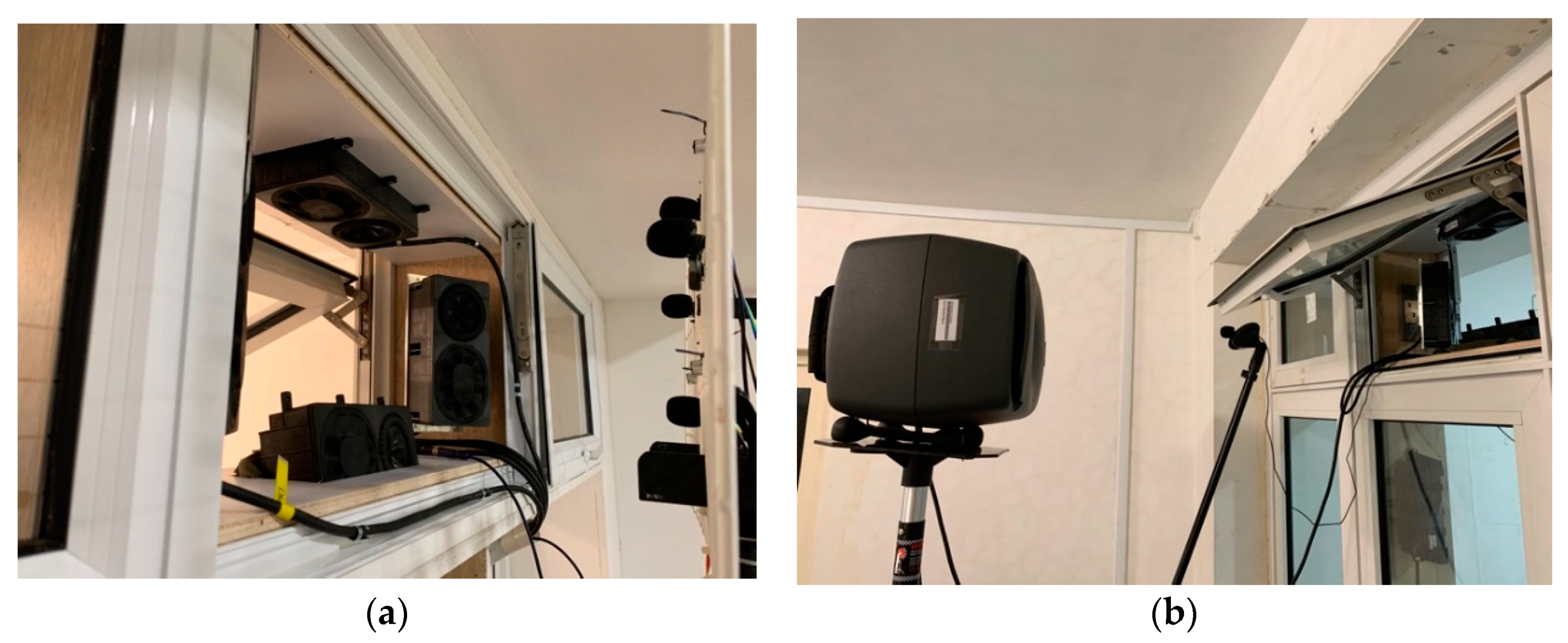
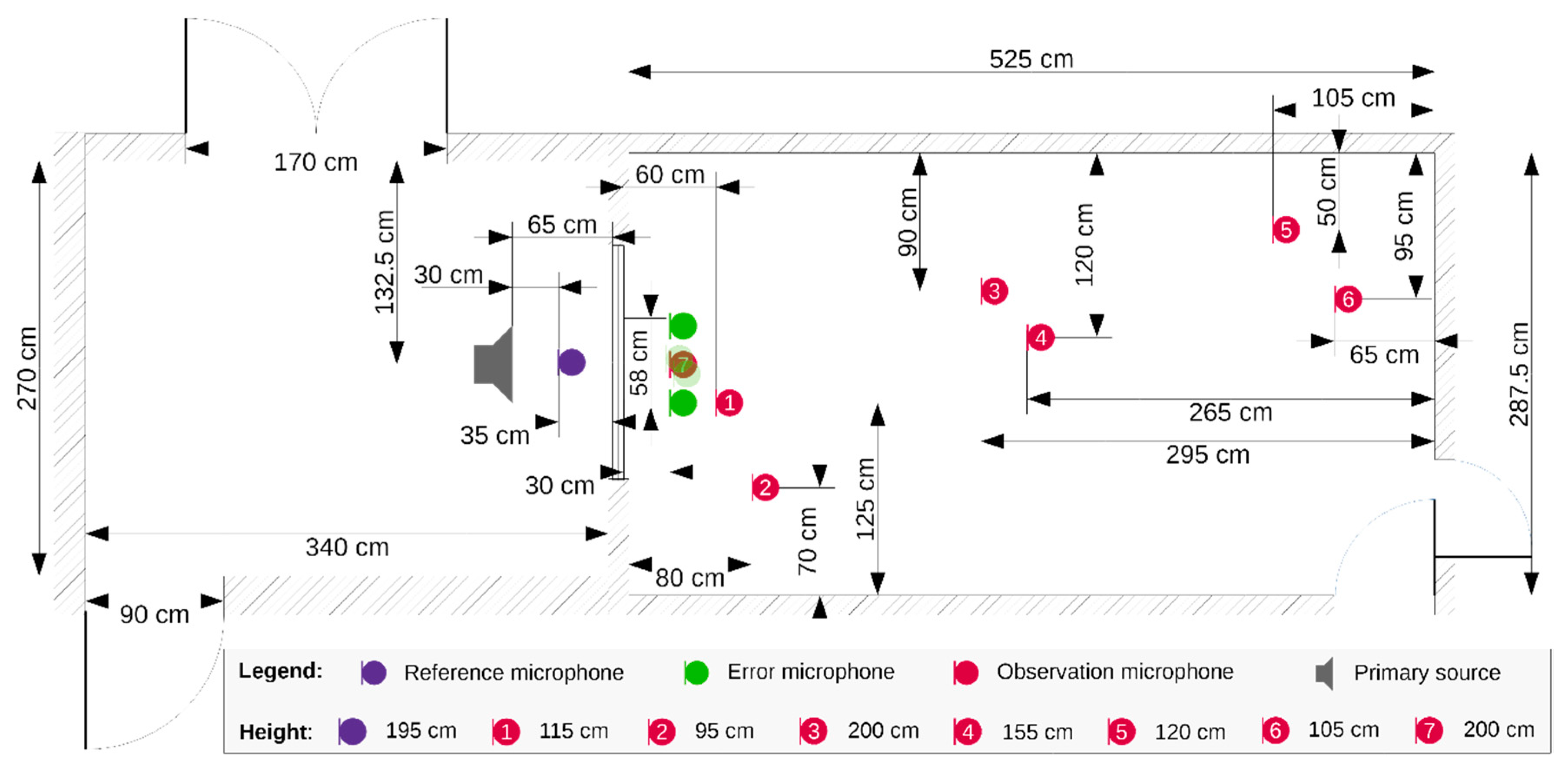
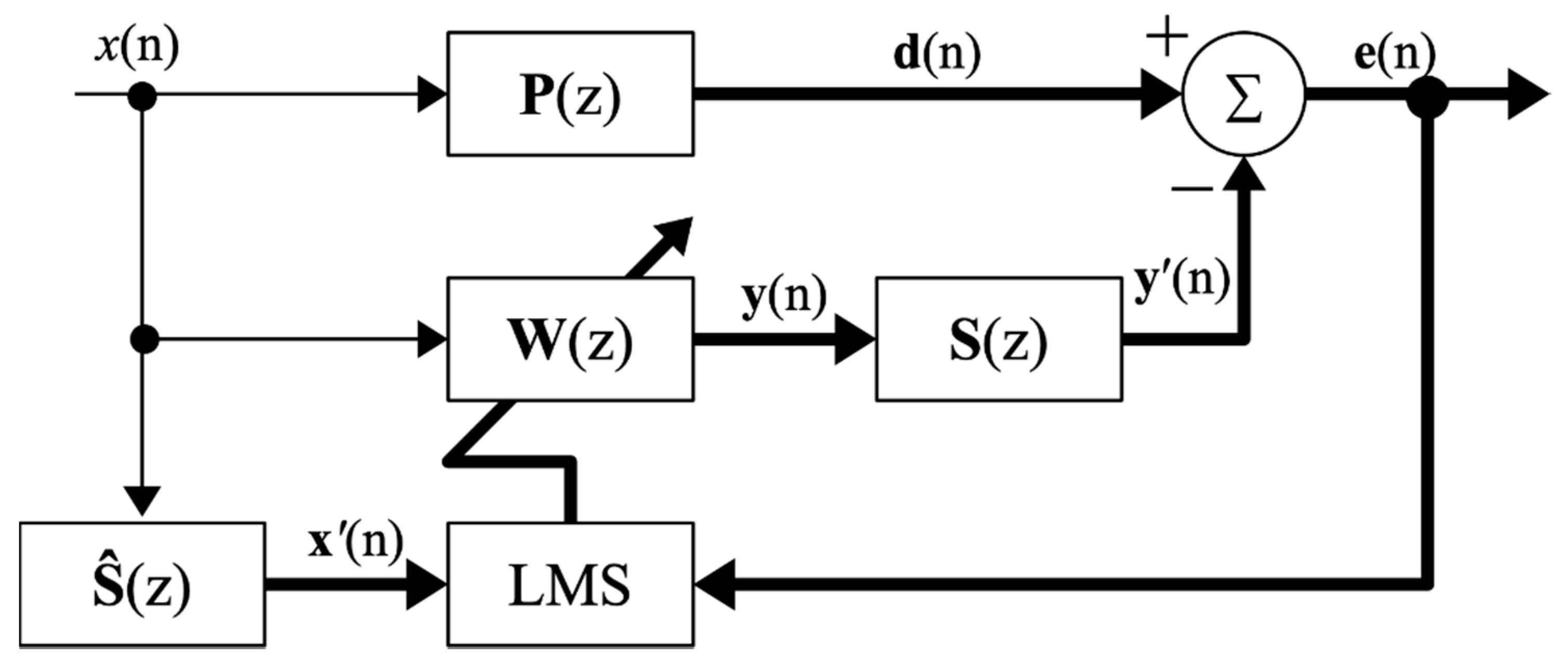

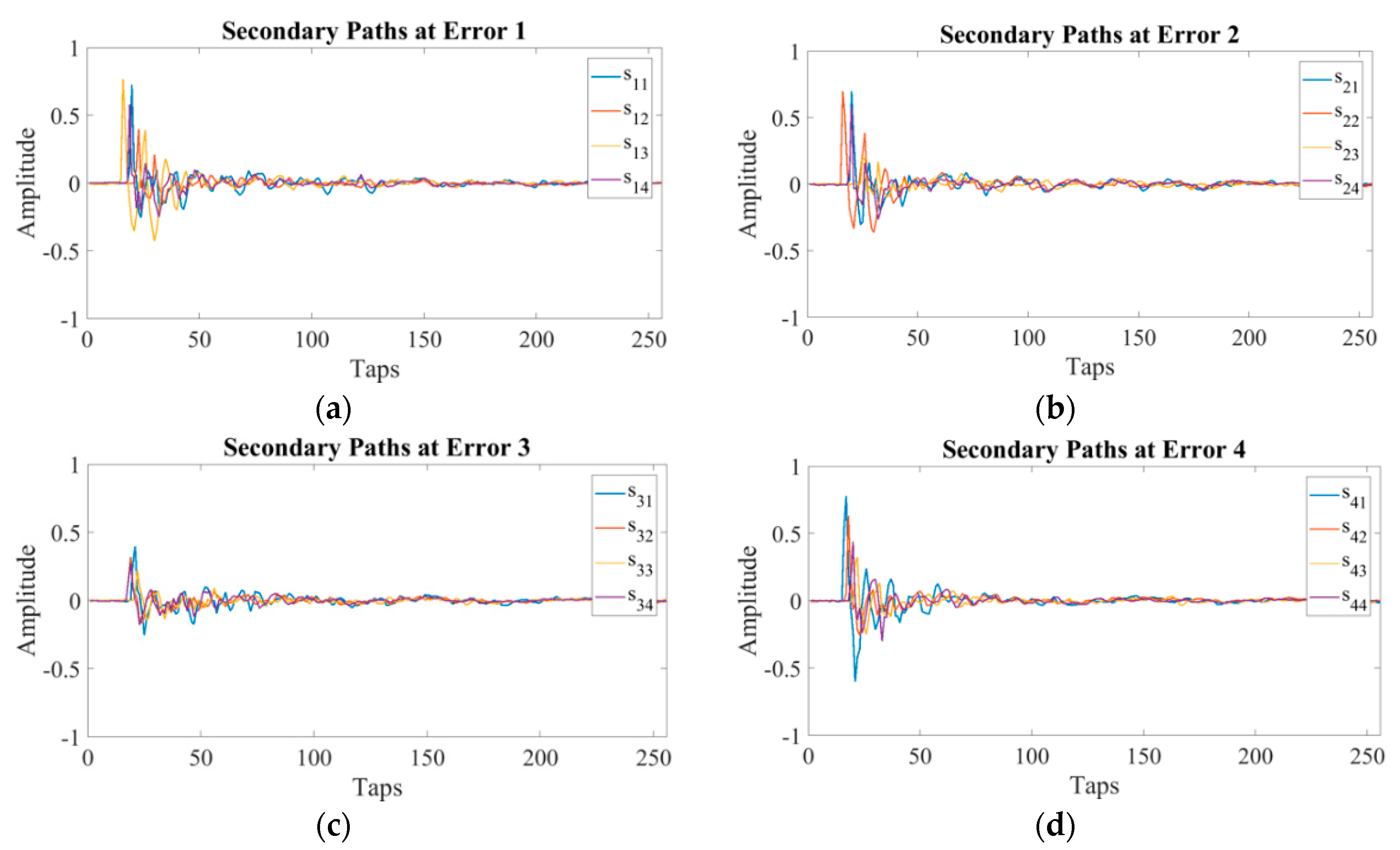
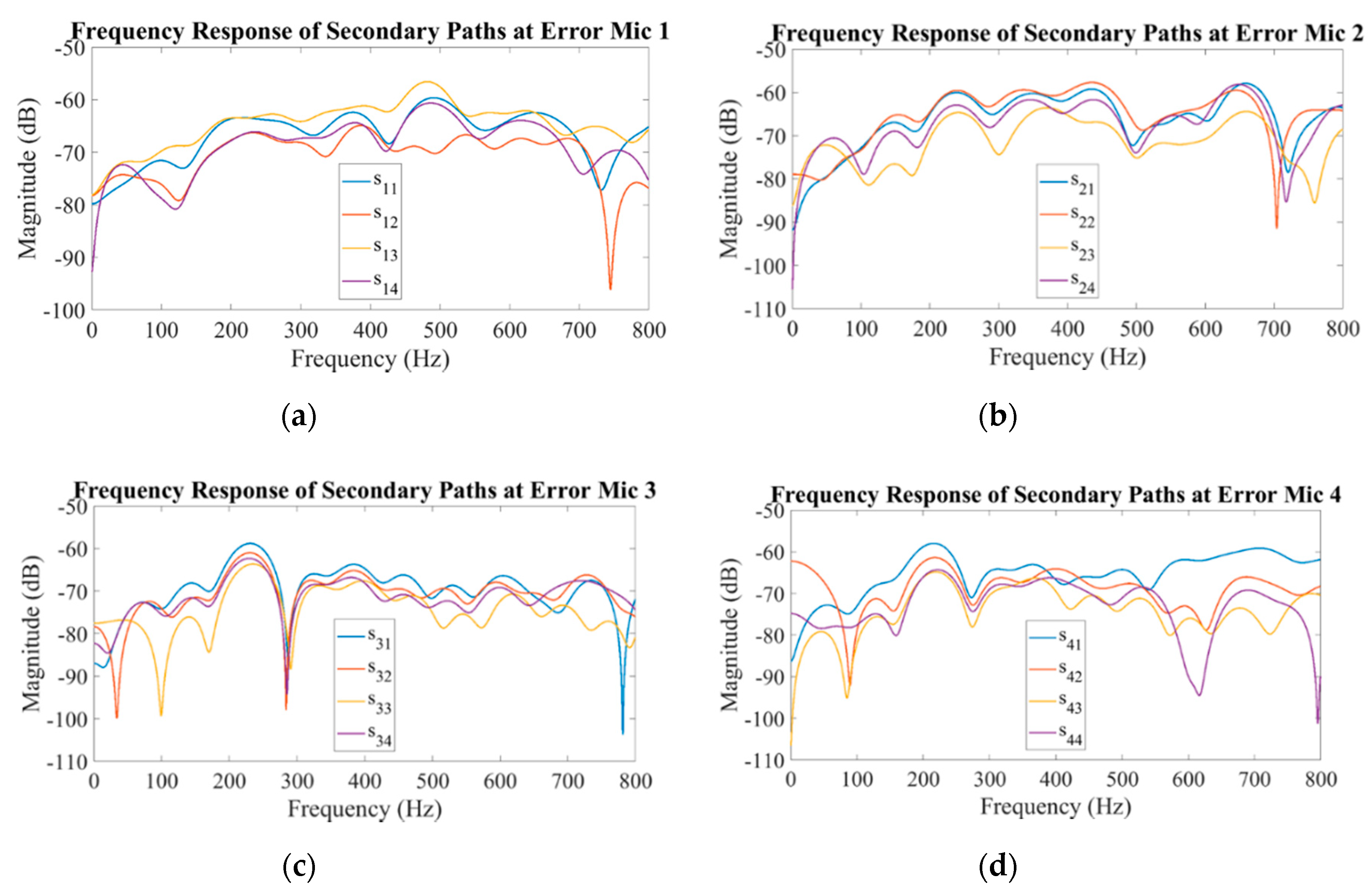

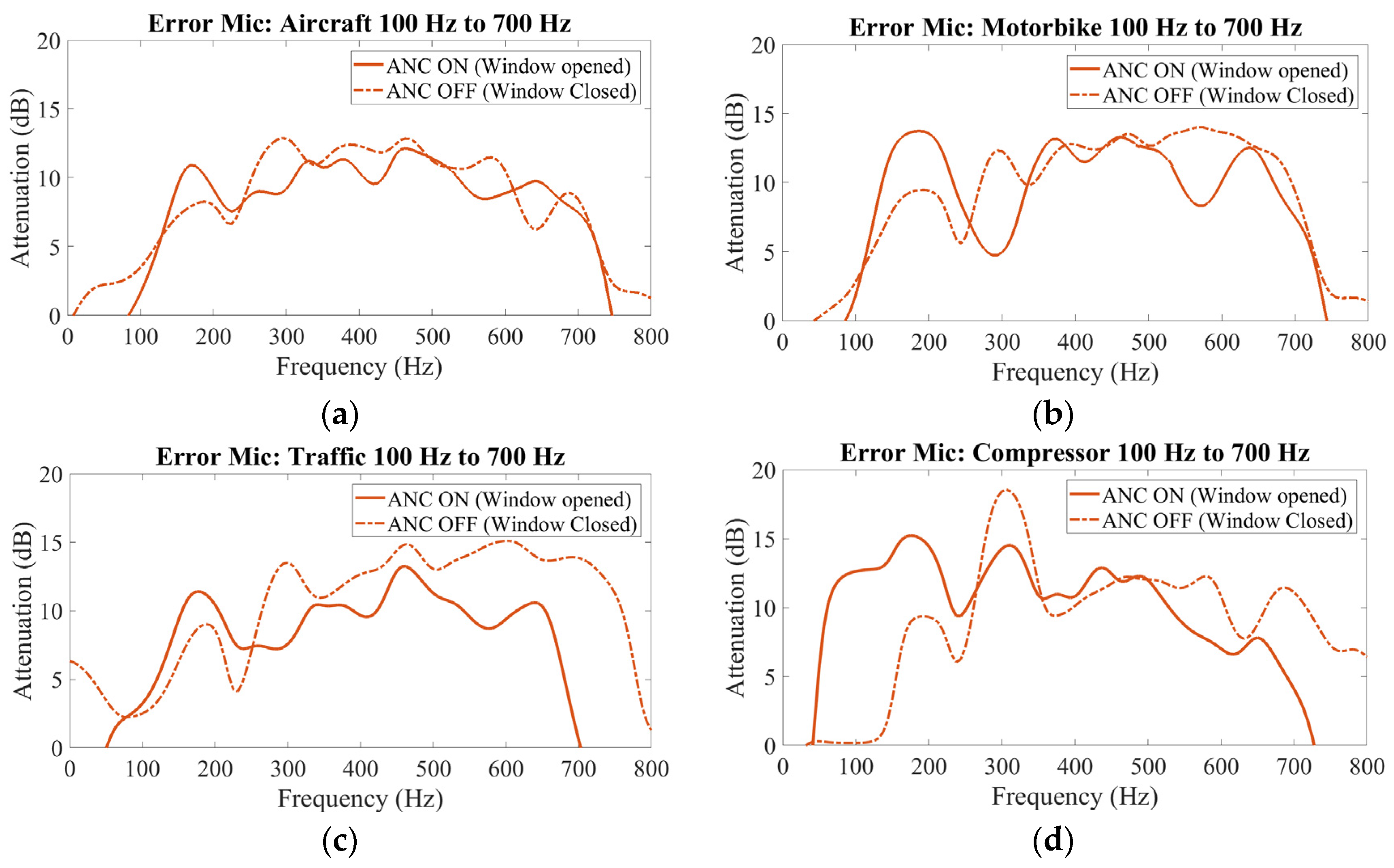
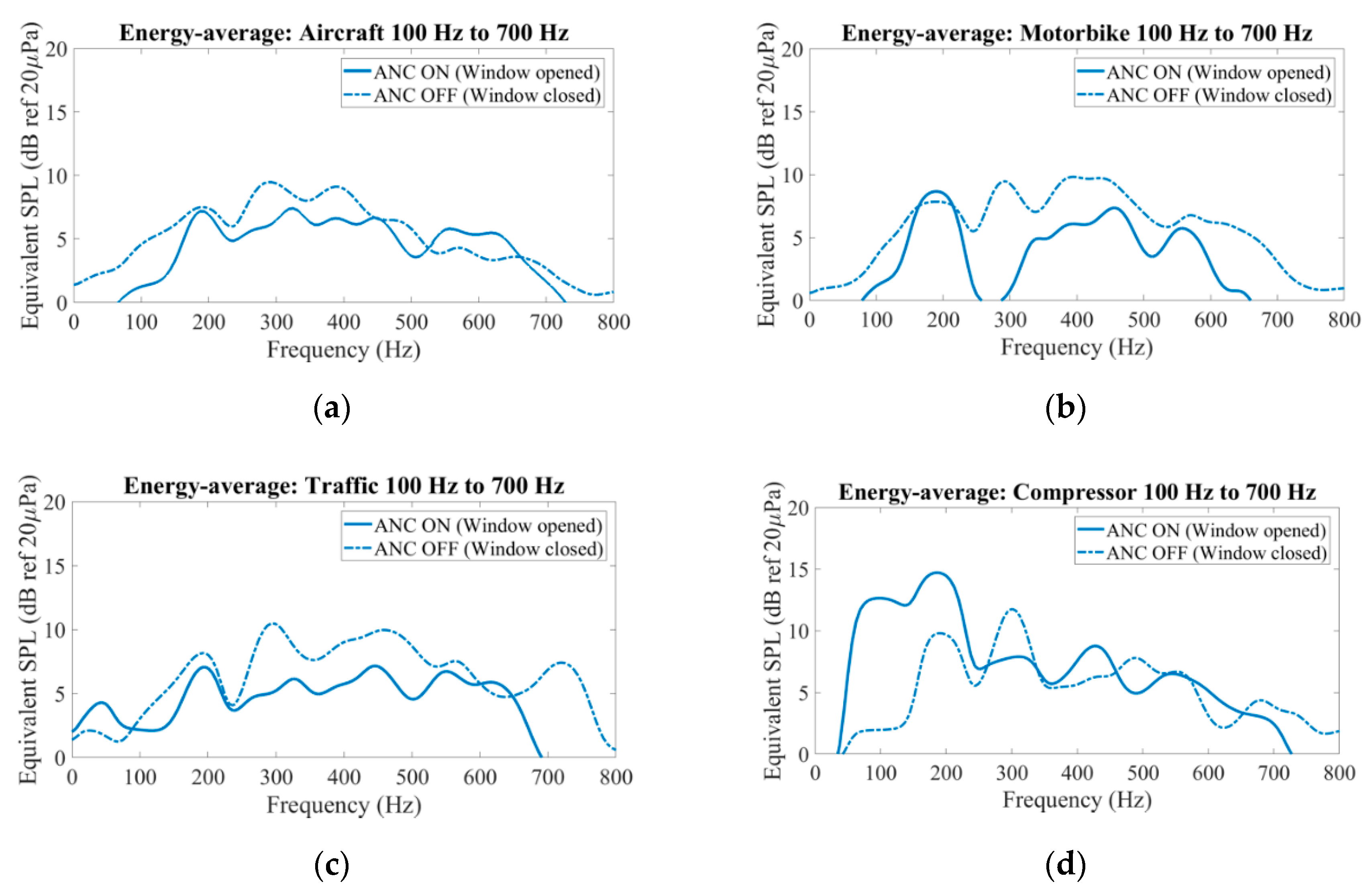
| Reference microphones | |
| Control sources and filters | |
| Error microphones | |
| Sampling rate | 16,000 Hz |
| Control filter length, | 640 |
| Secondary path length | 256 |
| Step size | 1 × |
| Noise Types | Aircraft | Motorbike | Traffic | Compressor |
|---|---|---|---|---|
| Duration, s | 47.2 | 16.41 | 13.19 | 10 |
| Frequency range, Hz | 100 to 700 | 100 to 700 | 100 to 700 | 100 to 700 |
| Recording location | Residential | Industrial | Residential | University |
| Description | Jet aircraft flyby | Motorbike passing by | Non-peak traffic from expressway | Adjacent to source |
| Mode of Operation | Attenuation of Primary Noise Types (dB) | ||||
|---|---|---|---|---|---|
| Aircraft | Motorbike | Traffic | Compressor | ||
| ANC ON (window opened) | 9.5 | 8.97 | 7.99 | 12.36 | |
| 5.76 | 4.84 | 4.56 | 10.51 | ||
| ANC OFF (window closed) | 9.98 | 10.09 | 10.77 | 6.47 | |
| 5.66 | 6.57 | 6.45 | 4.85 | ||
© 2020 by the authors. Licensee MDPI, Basel, Switzerland. This article is an open access article distributed under the terms and conditions of the Creative Commons Attribution (CC BY) license (http://creativecommons.org/licenses/by/4.0/).
Share and Cite
Lam, B.; Shi, D.; Belyi, V.; Wen, S.; Gan, W.-S.; Li, K.; Lee, I. Active Control of Low-Frequency Noise through a Single Top-Hung Window in a Full-Sized Room. Appl. Sci. 2020, 10, 6817. https://doi.org/10.3390/app10196817
Lam B, Shi D, Belyi V, Wen S, Gan W-S, Li K, Lee I. Active Control of Low-Frequency Noise through a Single Top-Hung Window in a Full-Sized Room. Applied Sciences. 2020; 10(19):6817. https://doi.org/10.3390/app10196817
Chicago/Turabian StyleLam, Bhan, Dongyuan Shi, Valiantsin Belyi, Shulin Wen, Woon-Seng Gan, Kelvin Li, and Irene Lee. 2020. "Active Control of Low-Frequency Noise through a Single Top-Hung Window in a Full-Sized Room" Applied Sciences 10, no. 19: 6817. https://doi.org/10.3390/app10196817
APA StyleLam, B., Shi, D., Belyi, V., Wen, S., Gan, W.-S., Li, K., & Lee, I. (2020). Active Control of Low-Frequency Noise through a Single Top-Hung Window in a Full-Sized Room. Applied Sciences, 10(19), 6817. https://doi.org/10.3390/app10196817







